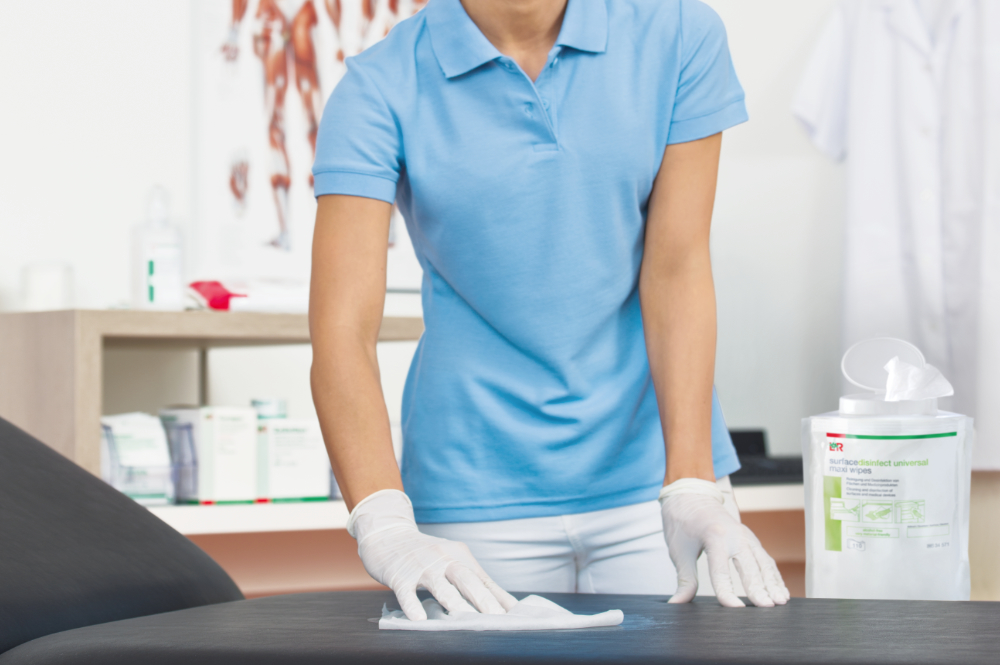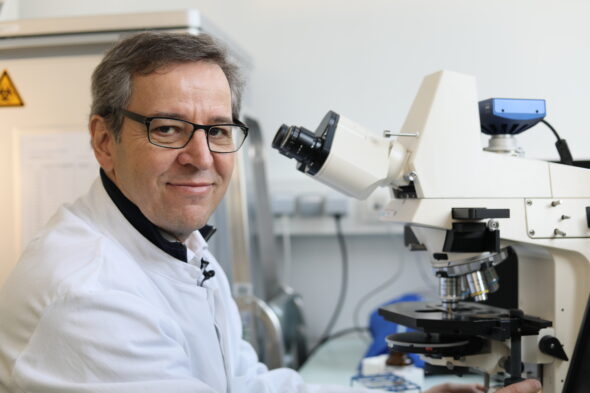Medical personnel may not be aware of the risk of infection
Hand hygiene is still not sufficiently and consistently implemented. One possible reason is that medical personnel do not... read more

In recent years, ready-to-use wipes have become increasingly popular for surface disinfection. They are easy to work with and safe to use. But how do experts test the effectiveness of such wipes systems and wipes dispenser systems? Learn about the role of 4-field test and why the number of moist wipes in flowpacks matters – and how institutions such as Germany’s VAH with its disinfectant experts are working to improve products.
Bacteria and viruses are invisible to the human eye. The effectiveness of surface disinfectants cannot be seen with the naked eye, either. However, safe products are essential for daily clinical use or in an outpatient setting. This is why reliable test methods and binding standards are crucial. By 2013, at the European level, the proof of efficacy for surface disinfection in the human medical sector was carried out exclusively on active ingredient solutions. At the same time, more and more ready-to-use systems came onto the market that offered wipes and disinfectants as a unit. Both at the European level and in Germany, the practical efficacy tests used not only ignored the interaction of the wipe and disinfectant solution, but these were also partly not intended for human medicine. Dr Jürgen Gebel, who heads the Office of the Disinfectants Commission in the Association for Applied Hygiene (in German: Geschäftsstelle der Desinfektionsmittelkommission im Verbund für Angewandte Hygiene e.V. – VAH) explained a further aspect: “In contrast to ready-to-use methods, in previous tests, we always used a surplus of liquid. The wipe was dipped in a bucket, soaked with disinfectant, and the surfaces were then disinfected." However, this test method led to a number of problems. It was not possible to determine whether the amount of active substances actually released by a wipe in ready-to-use procedures was sufficient to inactivate microorganisms on a surface. Wiping can also lead to cross-contamination – which was also not detectable in the test. In practice, these weak points can lead to an infection risk for users and patients.
“Disinfectants are used to reduce the risk of infection for patients," Gebel adds. "Users must be able to rely on the direct benefit of the agent, because they cannot see it directly. This is why you have to use appropriate test methods for testing the efficacy of the product beforehand,” continues Gebel. It was very important for Gebel and his team at the Institute for Hygiene and Public Health at the University Clinics in Bonn, Germany to eliminate these weak points and to test the effectiveness of disinfectant wipes in practice. So, they developed the 4-field test. This is a quantitative test method for assessing the bactericidal, levurocidal, fungicidal, mycobactericidal and sporicidal effects of disinfectant wipes for the medical field.
The wipe is moved across a non-porous surface (mostly PVC floor covering or PVC foam board (“FOREX ®”)) over four marked fields by means of a granite block (see info graphic). The first field is contaminated with test organisms, whereas there are no test organisms on the other three fields. The new method is a closer representation of real-life situations and treats the disinfectant solution and wiping activity as a unit, rather than evaluating the solution alone. “The advantage of the test is that it represents not only the reduction of the test organisms on the test field itself, but also a possible spread of the test organisms to other test fields,” Gebel explains, “The test makes it possible to confirm the effectiveness during the entire period that the wipe is used.”
In 2013, Dr Jürgen Gebel and his team submitted the procedure as a pre-standard in the European standards group (see text box: European standards on efficacy testing). Their motivation was clear. “There is one Europe, and its borders are very open. There is no way that Germany could use a border to protect itself from infections or the transfer of pathogens. And that is why our efforts must be directed at establishing high quality standards in all European countries. For this reason, VAH also takes a great interest in implementing uniform and standardised test procedures at the European level.” And has been successful, because in 2015, the process became recognised as Standard EN 16615 in in the European Union. “Yes, that does make one proud,” adds Gebel.
In addition to the development and establishment of new testing methods, the VAH has another important function. The association continually compiles and updates the disinfectants list, another responsibility that Dr Gebel carries out. The VAH list is the list of disinfectants and procedures tested by the VAH. For example, surface disinfection products are divided into three categories: “surface disinfection” (without specified wipes) and surface disinfection as “pre-soaked wipe systems” or “ready-to-use wipe systems”. “Since 2016, all surface disinfectants have had to prove their effectiveness by means of the 4-field test in at least one expert appraisal,” explains Gebel. Last year, however, the transitional period ended. Since 2019, both expert appraisals that are required for listing must have been conducted according to this test procedure. The VAH updates the list on a monthly basis and makes it available online. Under the heading “surface disinfection”, products with the word “cloth” or “wipe” in the name (without specified wipes) are still listed, but these are specially labelled. Because here only the effectiveness of the wetting solution is tested with a standard wipe. The situation is different with the categories “pre-soaked wipe systems” or “ready-to-use” system. “The user can trust that the pre-soaked wipe system or ready-to-use system has been tested and found to be an effective product. It ensures compatibility between the wipe and the disinfectant,” says Gebel.

###Is time relative? Contact times are continually adjusted by the VAH
In addition to the subdivision into the three categories, the contact time also plays a role. The VAH currently lists products with a contact time of five to 60 minutes. However, when certifying for five minutes, a contact time of one minute must also be tested. Gebel explains the reason for this as follows.
“We want to be sure that the effective area is safely separated from the ineffective area. Since it is not possible to modify the concentration in ready-to-use systems, we try to set the limit of the process via the contact time.” This methodology could soon lead to a further update of the VAH list for disinfectants, as there are products that work within one minute. “There is a growing discussion about whether to introduce contact times shorter than five minutes. The VAH is considering listing products with a contact time of one minute.”
The reaction time not only plays a role in the effectiveness of products, but also has an influence on the microorganisms themselves. Often, long contact times are synonymous with low concentrations of active ingredients. “If the pathogens are not immediately inactivated, they can develop certain protective mechanisms. This effect is called tolerance – not to be confused with resistance. Tolerances are time-limited, adapted properties that are subsequently lost,” the VAH expert explains. Nevertheless, they raise the risk of infection for patients and users. That is why more and more disinfectant formulations are approved under biocide laws. Last year, the European Chemicals Agency ECHA published a document that included guidelines for the use of surface disinfectants in healthcare. According to the Biocidal Products Regulation (Biocidal Products Regulation, BPR, the maximum contact time of “high-touch-surfaces”, i.e. frequently touched surfaces in the patient environment, is five minutes. “With regard to the risk of infection, we at the VAH recommend very short contact times – this is the case with these highly frequented areas. When however, surfaces only have to be disinfected once a day where there is no visible contamination, longer contact times are justified,” Gebel explains.
The ECHA prescribes a maximum of 60 minutes for the latter areas – in Germany, a contact time of four hours has been established, especially for floors. “The tendency is for people to deviate from this following observed development of tolerances in microorganisms. The VAH now also follows the guidelines of a maximum of 60 minutes, which is regarded as a consensus at European level.” The contact times recommended by ECHA are based on the European Standard EN 14885. Here, too, the contact times are five and 60 minutes respectively. “The VAH accepts the concentrations and contact times specified by biocide legislation. However, this does not mean that the VAH does not impose additional quality requirements for verifying the specified values. In future, the VAH list will become a positive list of biocides approved by ECHA,” Gebel summarises.

But not only the contact time is relevant, the degree of saturation in each tissue is also important. This was stated by the chemist and disinfectant expert Dr Roland Knieler in his latest study “Quality and testing of ready-to-use disinfectant wipes”. “When I opened a pack of ready-to-use wipes, I noticed that the top ones were very dry. With a second pack, however, the top wipes were dripping wet,” says Knieler, describing the incentive for his research work. “Only then did I realise that the second pack had been stored upside down. It was immediately clear to me that something must be going on inside the wipe packages.” In addition, there were indications from the VAH that the content of disinfectant per wipe had an influence on effectiveness. “I had to take a closer look.”
In preliminary tests, Dr Knieler investigated different packaging concepts for ready-to-use disinfectant wipes. The result was that flowpacks (stacked wipes wrapped in a thin plastic package with an opening at the top) showed the greatest difference between the moistness of the first wipes and that of the last. “This is understandable since gravity has a greater effect on stacked wipes than, for example, on rolls of tissues standing upright in the container. That’s why I concentrated on flowpacks in the study.”
Knieler is aware of the relevance of his work: “Ready-to-use disinfectant wipes are now indispensable in clinical everyday life, in outpatient practices and other patient care facilities. Their advantages are obvious, because they are easy and safe to use.” In addition, the time-consuming preparation of disinfectant solutions and the processing of used cloths, the danger of incorrect dosages, as well as the risk of bacterial contamination are all reduced – (LINK to Interview with Dr Günther) – which improves the infection prevention. These advantages are also reflected in the sales figures. At the beginning of 2018, annual sales of ready-to-use disinfectant wipes in German acute-care hospitals alone amounted to almost EUR 20 million, with annual growth of over 25 per cent. In comparison, the turnover of surface disinfection concentrates, which were still dominant a few years ago, is falling continuously and is currently at an annual value of just under EUR 7 million.1
Knieler then examined a total of nine commercial flowpack products with alcohol-based wipes as well as alcohol-free wipes for the quantity of liquid per wipe and the degree of saturation (quantity of liquid per wipe in g/weight in g x 100). Depending on the product, the differences between the first and last wipes also varied. “Some products contained less than a third of the liquid in the first wipes than in the last. That’s an enormous difference,” says Knieler (see diagram). The expert also observed another connection: The more wipes the flowpack contains, the lower the degree of saturation of the first cloths. “The aim should be to achieve a uniform quality of the wipes within a pack. This is the case for flowpacks with a lower number of wipes – around 60. They are more evenly moistened – their saturation quality is more uniform. Here even the first cloths are pleasantly moist, you will notice this when you touch them.”

Based on these observations, Dr Knieler went one step further in his study. “For products that have 80 or more cloths stacked on top of each other, the first cloths are quite dry. When one considers that the amount of liquid applied to the surface influences the effectiveness and thus depends on the impregnating liquid per cloth, an additional test was necessary,” he explains. The 4-field test developed by VAH according to EN 16615 was used here. Knieler used samples that only differed in their degree of saturation and had them tested for their microbiological effectiveness. The aim of the experiment was to find out whether there is a lower limit of efficacy of ready-to-use wipes products that depend on the degree of saturation. This has been confirmed. “A sufficient quantity of disinfectant per wipe is one of the decisive factors for reliable effectiveness,” explains Knieler.
"Of course, further questions immediately come up: Is there sufficient effectiveness of the first wipes in flowpack products with a lower degree of saturation of less than 200 per cent? How can the user be sure that the first wipes are effective? I can’t answer that – but I suggest that the makers responsible for such wipes prove the effectiveness of the product in a worst-case approach,” Knieler reports. He defines a product by the type and quantity of active ingredients in the disinfectant solution in combination with the material of the wipe. Then the 4-field test is carried out on the wipe with the smallest dimensions, the lightest weight per unit area and the smallest amount of liquid per wipe of the product variants to be certified – the “assumed worst case”. This would have the advantage that all product variants – regardless of the number of wipes or packaging – would be covered by worst-case testing with larger or heavier wipes and larger quantities of liquid.

###Motivation for innovations in surface disinfection
It is now 2019: Although great progress has been made in recent years in the testing, listing and testing of surface disinfection, experts such as Dr Roland Knieler and Dr Jürgen Gebel from VAH are still a long way from reaching their goal.
“Our motivation to continue to devote ourselves to new test procedures and new problems simply comes from our conviction that disinfection is an essential building block in hospital hygiene,” says Gebel. He and his team recently achieved another success in Bonn – namely in the fight against a particularly significant pathogen in Germany, Clostridium difficile: At European level, the VAH has established a suspension test for the testing of sporicidal agents, which now – after 14 years – has resulted in EN 17126. In addition, based on the 4-field test, a method (VAH Method 19) was established with which sporicidal agents can also be tested on surfaces.
“At the end of the day, scientific studies always lead to innovation,” Knieler says. “Of course, it’s always a difficult situation when a product that you study doesn’t perform as it should. But at the same time, it is always the starting point for something new and better.” In future, this motivation will continue to guide the experts in their work. Gebel says, “Disinfection is an incredibly important tool for infection prevention. And it is a good feeling that we are there for the well-being of the patient and the user, without being seen and without being recognised.”
The European standards have meanwhile become the standard for testing the effectiveness of disinfectants within the European Union and are dealt with in the Working Groups (WG) of the Technical Committee CEN/TC 216 “Chemical disinfectants and antiseptics”. According to the requirements of EN 14885, the efficacy test is carried out in a multi-stage process, whereby phase 1 contains purely qualitative suspension tests for screening purposes and is not relevant for marketing authorisation. Phase 2 is divided into quantitative suspension tests (stage 1) and practical tests (stage 2). The European standards are continually revised and updated. Sometimes there are purely editorial changes, sometimes substantial changes that lead to a new test with the updated standard.
Further information